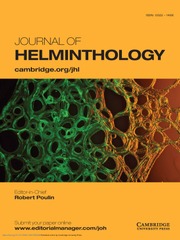No CrossRef data available.
Article contents
Eye metacercariae in invasive pirarucu Arapaima gigas (Pisces: Arapaimidae): A potential ecological sink interaction?
Published online by Cambridge University Press: 17 February 2025
Abstract
Biological invasions are among the main threats to global biodiversity and present the potential to disrupt host-parasite dynamics. In Brazil, the scientific reports of the occurrence of the Amazonian fish ‘pirarucu’ (Arapaima gigas) in the upper Paraná River basin, São Paulo state, were made in 2015. However, the effects of its introduction are still unknown, including those associated to its host-parasite relationships. As part of our studies on the possible effects of A. gigas introduction into this basin, the parasites from the eyes of 60 specimens of A. gigas were evaluated. We reported the occurrence of Austrodiplostomum compactum metacercariae (Trematoda, Diplostomidae) parasitizing the eyes of A. gigas supported by morphological and molecular data (COI mtDNA). The new partial sequences had a similarity of 100% to other sequences of Au. compactum previously deposited in Genbank. Five hosts (Prevalence = 8.33%) with a standard length between 69 and 116 cm were infected, with a mean intensity of infection of 31.8 ± 17.2 (1–93). Large infected hosts are unlikely to be a significant prey item for the definitive hosts (medium-sized piscivorous birds), and could act as an ‘ecological sink’, disrupting the transmission of this metacercariae. Hosts with high infection rates by these metacercariae may present cataracts, exophthalmos, and blindness, resulting in loss of visual acuity. Considering that A. gigas is a carnivorous and visual predator, the low infection observed possibly does not act as a biological filter to hinder or contain the invasion, probably presenting a low negative effect on the visual acuity of hosts.
- Type
- Research Paper
- Information
- Copyright
- © The Author(s), 2025. Published by Cambridge University Press


